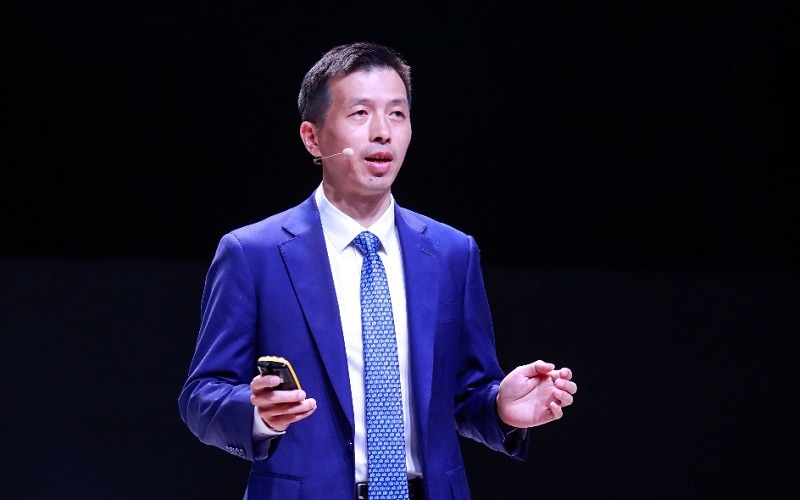[Barcelona, Spain, February 28, 2023] At the Going Green Summit held by the GSMA in Barcelona, Huawei proposed a green industry vision oriented to the future network evolution.
Peng Song, President of ICT Strategy & Marketing at Huawei, said that everything in the universe is based on matter, energy, and information. He explained that matter is the materials we need, energy is the driving force, and information is our knowledge, and that everything people do depends on these three elements.
 Peng Song, President of ICT Strategy & Marketing at Huawei, delivered a keynote speech titled “Transcend Limits to Light up a Green Future”
Peng Song, President of ICT Strategy & Marketing at Huawei, delivered a keynote speech titled “Transcend Limits to Light up a Green Future”
According to Peng, this model of matter, energy, and information determines whether we can create a green world and has been used by Huawei to guide its product and solution innovation. Using this model, Huawei has proposed a vision for green industry development to adapt to future network evolution:
1. Matter: Key technological innovations unlock hardware potential
Building on its research in basic theories and materials over the past 30 years, Huawei has been working to increase the energy conversion efficiency of hardware. Related material research has been a key part in creating new breakthroughs in disruptive sensing technologies.
- For example, the Signal Direct Injection Feeding (SDIF) technology that Huawei uses in antennas removes the 100 meters of feeders currently used inside antennas, reducing feeder loss and increasing antenna efficiency by 15%.
- Huawei has also pivoted to deep dormancy features to increase energy savings for 5G. Huawei’s next-generation AAU, which is currently being planned, will shut down most radio frequencies and digital channels when networks are idle, and only keep interface power supply on. This will cut power use from 300 watts to 10 watts, making “zero bits, zero watts” a reality.
- When it comes to materials innovation, the company is also exploring many areas, including its self-developed titanium-plated and high-conductivity power amplifiers that use diamond substrates. These new materials reduce the energy consumption of power amplifiers by 21%.
2. Energy: Native intelligence makes networks more energy-efficient
For energy, Peng said, the industry should focus more on the efficient flow and conversion of energy in networks. For example, when energy makes its way into a network, most of it is used for processing data flows, while some of it is converted into wasted heat. To improve energy efficiency, Huawei has introduced native intelligence into its next-generation green network architecture, which covers three layers:
- At the NE layer, equipment is intelligently aware of energy consumption and can adapt it to service needs.
- At the network layer, sites can intelligently collaborate to save energy. This can minimize network-wide energy consumption.
- At the service layer, the cloud intelligently performs modeling and analysis using experience and energy efficiency data. It also trains models and optimizes algorithms for specific energy-saving scenarios. This enables intent-driven, scenario-based energy saving.
3. Information: Software algorithm reconstruction unlocks data value
Peng further explained that in terms of information processing, Huawei is working to reconstruct software algorithms for more efficient information scheduling and management. Currently, AIGC is very popular. The interaction mode is changed from traditional text to multimedia interaction such as graphic, text, and video. In addition, the interaction frequency is greatly increased. Huawei estimates that this app will create an additional 13.5 GB DOU per month and drive a 100-fold increase in carrier network traffic and a 25-fold increase in network energy consumption by 2030. This means future networks will need better information scheduling and management.
To address this challenge, Huawei has developed a mobile intelligent engine that can replace manual data collection and analysis. It automatically acquires data about site coverage, loads, and services, and uses an intelligent platform to analyze, learn, and model this data in real time. This digital model can generate site-specific energy saving policies based on the frequency bands and modules of each site. This allows for real-time scheduling and dormancy of resources in the frequency, spatial, time, and power domains, maximizing software energy saving while ensuring a consistent user experience.
At the end of his speech, Mr. Peng Song said that Huawei will continue investing in fundamental theories, materials, and algorithms to overcome key technological barriers in matter, energy, and information, and that this will give the company the capabilities required to create products and solutions with optimal performance and energy efficiency, and ultimately lead the industry to a greener future.
MWC Barcelona 2023 runs from February 27 to March 2 in Barcelona, Spain. Huawei showcases its products and solutions at stand 1H50 in Fira Gran Via Hall 1. Together with global operators, industry professionals, and opinion leaders, we dive into topics such as 5G business success, 5.5G opportunities, green development, digital transformation, and our vision of using the GUIDE business blueprint to lay the foundation for 5.5G and build on the success of 5G for even greater prosperity. For more information, please visit: https://carrier.huawei.com/cn/events/mwc2023
PR Archives: Latest, By Company, By Date